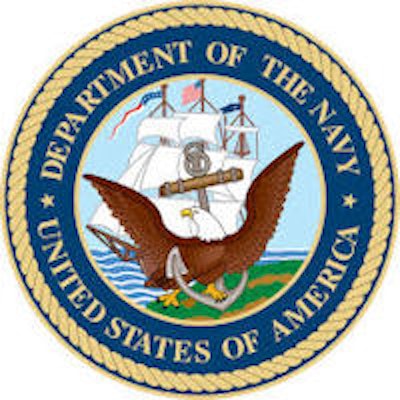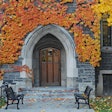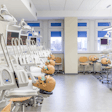
This article is reprinted with permission of the Navy Office of Community Outreach.
From the trenches of World War I to the battlefields of Afghanistan, the U.S. Navy's Dental Corps continues to move forward as it begins its second century of service.
With more than 1,300 active and reserve officers, the Dental Corps has matured into a world-class dental healthcare organization providing care for sailors, marines, military beneficiaries, and countless others.
"If the fighting force has high-quality dental care, they will be effective war fighters," said Lt. CmDr. Andrea Lisell, a Navy dentist and now a second-year endodontic resident at the Naval postgraduate school at Walter Reed National Military Medical Center. " 'Fit to bite, fit to fight' is a common phrase heard around the dental clinics when I was stationed at Marine Corps Recruit Depot Paris Island, South Carolina."
Navy dentists routinely deploy aboard more than 46 ships as well as part of marine expeditionary units as individual augmentees to places such as Guantanamo Bay, Iraq, Afghanistan, Kuwait, the Horn of Africa, and across the Pacific. They do this while maintaining high operational readiness and setting the standard for excellence, research, humanitarian assistance, health promotion, and prevention around the world.
Seeking a greater challenge
Leaving a successful private practice in New York City after 20 years, Lt. CmDr. Frederic Giauque, the dental department head aboard USS Essex (LHD-2), sought his next challenge to fulfill a long-time dream of serving in the Navy.
"I joined the Navy only three-and-a-half years ago, and I have found an incredibly supportive and challenging environment," Dr. Giauque said. "I chose to be with the Marines for my first tour, and the experience I got was simply extraordinary, arriving at 1st Dental Battalion at Camp Pendleton, California. This was the best move I have ever done."
Dr. Giauque spent five months in Helmand Province at Camp Leatherneck as part of the I Marine Expeditionary Force (Forward). During his deployment, he treated marines, sailors, coalition troops, civilians, even military dogs in tents equipped with all the latest technology, right in the middle of Afghanistan.
Navy dentists also deploy where their specialized knowledge or skills are needed to support the warfighter.
Dr. Lisell has deployed to Kuwait; Okinawa, Japan; Rota, Spain; and Afghanistan, working with sailors and marines, as well as in theater with a Navy construction battalion, more commonly known as Seabees. In addition to providing unit dental care, she set up a forward operating base, dug fighting positions, set up a basic aid station, provided triage for a mass casualty, and performed dentistry in the field.
"Not many dentists learn how to drive mine-resistant ambush protected vehicles or forklifts," Dr. Lisell said. "I was even licensed on a Humvee and earned their Seabee Combat Warfare Device."
Navy dentists also support humanitarian missions. They lead departments, clinics, and hospitals on land bases or at sea. They even provide dental care to the president of the U.S.
"Whether in peacetime supporting humanitarian assistance and disaster relief missions or in war, the officers of the Dental Corps will continually support the causes of dental readiness and dental health for those entrusted in our care," Dr. Giauque said.
Advances in dentistry
The U.S. Navy Dental Corps was established on August 22, 1912, when President William Howard Taft signed a bill from the 62nd Congress authorizing the secretary of the Navy to appoint 30 acting assistants dental surgeons to be part of the medical department of the Navy. The bill established the corps to have capabilities in all areas of dentistry and be of good moral character and unquestionable professional ability.
Since its charge, the U.S. Navy Dental Corps has grown to nearly 14 specialties, including comprehensive dentistry, endodontics, operative dentistry, oral and maxillofacial pathology, oral medicine and radiology, orthodontics, pediatric dentistry, prosthodontics, public health dentistry, and research dentistry.
"Advancements in dental technology have changed greatly," Dr. Lisell said. "I found this out for myself when I toured the museum aboard the decommissioned battleship USS North Carolina (BB-55). Navy dentists worked in austere conditions when compared to a modern operatory, but that didn't stop them from providing the best possible care to our war fighters during World War II."
Dr. Giauque noted that for 101 years, the main role of Navy Medicine's Dental Corps is to maintain operational readiness for sailors and marines no matter where they go.
"We have to be proud and preserve that legacy," he said.
Drs. Emory Bryant and William Cogan were appointed as the first Dental Corps officers on October 23 and 24, 1912. It wasn't until March 5, 1915, that Harry Harvey would serve aboard USS Solace (AH-5), becoming the first dental officer to serve aboard a ship. Assistant Dental Surgeon Lucian Williams reported to Parris Island on August 4, 1913, becoming the first dental officer to service with the U.S. Marine Corps. Since the Dental Corps founding, its officers have led their corps with distinction, earning 33 Bronze Stars, 17 Silver Stars, one Navy Cross, and two Medals of Honor awarded to Lt. CmDr. Alexander Lyle and Lt. j.g. Weedon Osborne for their heroic actions in France during World War I.
"I've come to realize that I'm a member of a proud line of professionals," Dr. Lisell said. "It's hard to predict where the Dental Corps will go from here, but I expect that it will be around for another century, and I am proud to be a part of it."
Joshua L. Wick is a writer for the U.S. Navy Bureau of Medicine and Surgery Public Affairs.



















